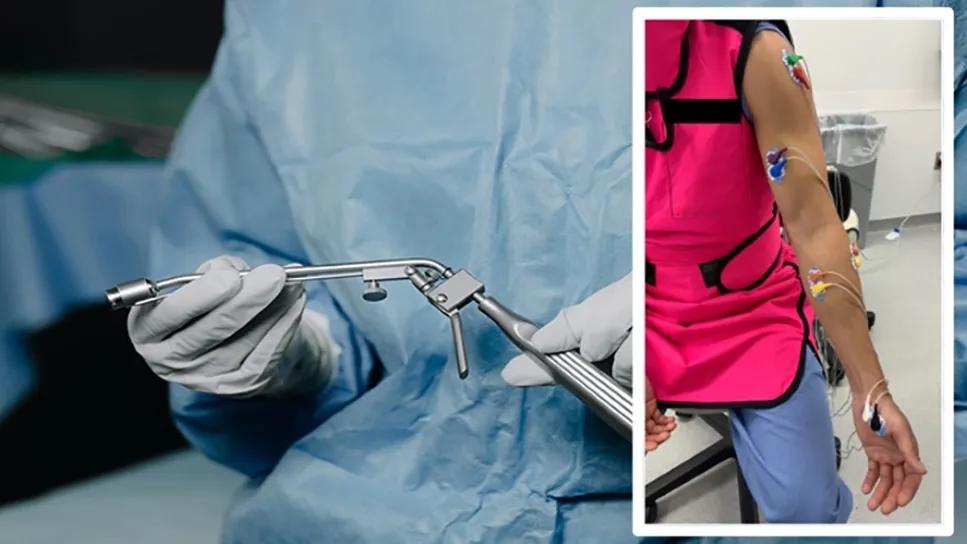Findings put into focus the reality of work-related injuries and physician burnout

Editor’s note: The article originally appeared on Cleveland Clinic Lerner Research News.
Advertisement
Cleveland Clinic is a non-profit academic medical center. Advertising on our site helps support our mission. We do not endorse non-Cleveland Clinic products or services. Policy
Female urologists experience higher muscle activation, greater physical workload and poorer ergonomics than their male counterparts during kidney stone surgery, according to a Cleveland Clinic study. The American Journal of Surgery publication provides data to address work-related injuries and prevent physician burnout.
More than 70% of United States surgeons experience work-related injury or pain over their careers. Nearly half report that their injuries impair their ability to work and care for patients and a significant portion of these individuals end up requiring surgery or physical therapy themselves. Despite growing attention to ergonomics, there's still not much information on sex differences, says Smita De, MD, PhD, HoLEP surgeon and endourologist at Cleveland Clinic.
"Even a minimally invasive procedure involves a lot of physical work and strain," says Dr. De. "There's a lot of movement involved in performing a surgery, but there's also a lot of heavy equipment that isn't really designed with shorter individuals or women in mind."
To address these problems, Dr. De, the study's lead author, teamed up with Kyle O'Laughlin, MS, a lead research technologist in Cleveland Clinic’s Department of Biomedical Engineering.
"Working with clinical professionals allowed me to gain knowledge of a different research field while providing them with my own expertise," he says. "Sharing our knowledge and expertise enhanced the quality and scope of this study, which will help it have a greater impact on urology surgical practice going forward."
Advertisement
O'Laughlin helped the physicians set up protocols to collect and analyze data from 14 Cleveland Clinic urology residents, fellows and junior staff. The team divided the physicians by sex (eight men and six women) and attached electromyography (EMG) sensors to their arms. EMG sensors track muscle contraction through electrical activity. O'Laughlin and the team determined where to place the sensors so they would not obstruct the residents' movement while collecting useful, accurate data.
Physicians performed a mock ureteroscopy, a routine procedure to remove kidney stones. After, they reported how they perceived the workload through a NASA Task Load Index (NASA-TLX) form. The researchers tested in multiple conditions, including whether the physician was sitting or standing and whether they were using a reusable or single-use ureteroscope.
For all positions and equipment types, women reported higher physical exertion NASA-TLX scores than their male counterparts. These reports were backed up by EMG measurements showing that female urologists required greater muscle activation in multiple muscle groups, especially in their forearms. Single-use ureteroscopes were less strenuous to use for both sexes.
With physician shortages at an all-time high, it is important to understand and combat what contributes to burnout. Hospital leaders consider many factors when selecting equipment and navigating budget limitations while prioritizing the well-being of their staff.
Dr. De says the sex distinctions uncovered in her study provide Cleveland Clinic with a better understanding of employee needs. She hopes findings aid leadership in informed decision-making when ordering and implementing equipment.
Advertisement
On a larger scale, Dr. De hopes her findings will help convince industry leaders to consider more ergonomic designs for their products.
"Industries don't usually modify their products with alternative ergonomics in mind," says Dr. De. "Ureteroscopes and similar surgical equipment have stayed pretty much the same shape for the past 20 years because there wasn't any research-backed evidence that things need to change."
Dr. De is also working with Vijay Krishna, PhD, Biomedical Engineering, to develop laser-activated nanoparticles that may allow for treatment of kidney stones without the need for strenuous surgeries.
Advertisement
Advertisement

A multidisciplinary research team conducted a comprehensive analysis of the cell populations within the human ureter

Meta-analysis assesses outcomes in adolescent age vs. mid-adulthood

Proteinuria reduction remains the most important treatment target.

IgA nephropathy is a relatively common autoimmune glomerular disease that can be diagnosed only by biopsy

Oncologic and functional outcomes are promising, but selection is key

Cleveland Clinic is first to use the device, known formerly as the UroMonitor

First single-port renal vein transposition reduces recovery time and improves outcomes

Approach offers a ‘middle ground’ between radical prostatectomy and active surveillance